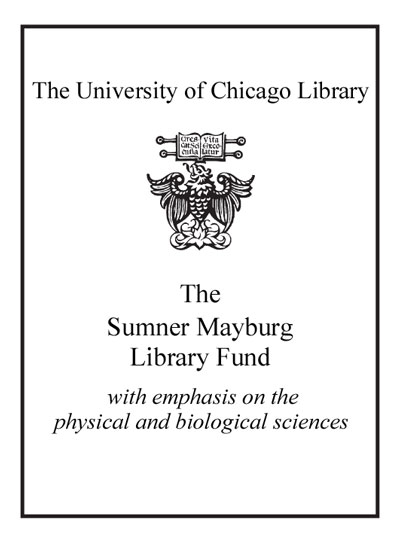Facts, conjectures, and improvements for simulated annealing /
Saved in:
| Author / Creator: | Salamon, Peter, 1950- |
|---|---|
| Imprint: | Philadelphia : Society for Industrial and Applied Mathematics, c2002. |
| Description: | xiii, 150 p. : ill. ; 26 cm. |
| Language: | English |
| Series: | SIAM monographs on mathematical modeling and computation |
| Subject: | |
| Format: | Print Book |
| URL for this record: | http://pi.lib.uchicago.edu/1001/cat/bib/4818610 |
Table of Contents:
- List of Figures
- Preface
- Acknowledgments
- I. Overview
- 1. The Place of Simulated Annealing in the Arsenal of Global Optimization
- 2. Six Simulated Annealing Problems
- 2.1. Problem Definitions
- 2.2. Move Classes
- 3. Nomenclature
- 4. Bare-Bones Simulated Annealing
- II. Facts
- 5. Equilibrium Statistical Mechanics
- 5.1. The Number of States That Realize a Distribution
- 5.2. Derivation of the Boltzmann Distribution
- 5.3. Averages and Fluctuations
- 6. Relaxation Dynamics--Finite Markov Chains
- 6.1. Finite Markov Chains
- 6.2. Reversibility and Stationary Distributions
- 6.3. Relaxation to the Stationary Distribution
- 6.4. Equilibrium Fluctuations
- 6.4.1. The Correlation Function
- 6.4.2. Linear Response and the Decay of the Correlation Function
- 6.5. Standard Examples of the Relaxation Paradigm
- 6.5.1. Two-State System
- 6.5.2. A Folk Theorem--Arrhenius' or Kramers' Law
- 6.6. Glassy Systems
- III. Improvements and Conjectures
- 7. Ensembles
- 8. The Brick Wall Effect and Optimal Ensemble Size
- 9. The Objective Function
- 9.1. Imperfectly Known Objective
- 9.2. Implications of Noise
- 9.3. Deforming the Energy
- 9.4. Eventually Monotonic Deformations
- 10. Move Classes and Their Implementations
- 10.1. What Makes a Move Class Good?
- 10.1.1. Natural Scales
- 10.1.2. Correlation Length and Correlation Time
- 10.1.3. Relaxation Time at Finite T
- 10.1.4. Combinatorial Work
- 10.2. More Refined Move Schemes
- 10.2.1. Basin Hopping
- 10.2.2. Fast Annealing
- 10.2.3. Rejectionless Monte Carlo
- 11. Acceptance Rules
- 11.1. Tsallis Acceptance Probabilities
- 11.2. Threshold Accepting
- 11.3. Optimality of Threshold Accepting
- 12. Thermodynamic Portraits
- 12.1. Equilibrium Information
- 12.1.1. Histogram Method
- 12.2. Dynamic Information
- 12.2.1. Transition Matrix Method
- 12.3. Time-Resolved Information
- 12.A. Appendix: Why Lumping Preserves the Stationary Distribution
- 13. Selecting the Schedule
- 13.1. Start and Stop Temperatures
- 13.2. Simple Schedules
- 13.2.1. The Sure-to-Get-You-There Schedule
- 13.2.2. The Exponential Schedule
- 13.2.3. Other Simple Schedules
- 13.3. Adaptive Cooling
- 13.3.1. Using the System's Scale of Time
- 13.3.2. Using the System's Scale of Energy
- 13.3.3. Using Both Energy and Time Scales
- 13.4. Nonmonotonic Schedules
- 13.5. Conclusions Regarding Schedules
- 14. Estimating the Global Minimum Energy
- IV. Toward Structure Theory and Real Understanding
- 15. Structure Theory of Complex Systems
- 15.1. The Coarse Structure of the Landscape
- 15.2. Exploring the State Space Structure: Tools and Concepts
- 15.3. The Structure of a Basin
- 15.4. Examples
- 15.A. Appendix: Entropic Barriers
- 15.A.1. The Master Equation
- 15.A.2. Random Walks on Flat Landscapes
- 15.A.3. Bounds on Relaxation Times for General Graphs
- 16. What Makes Annealing Tick?
- 16.1. The Dynamics of Draining a Basin
- 16.2. Putting It Together
- 16.3. Conclusions
- V. Resources
- 17. Supplementary Materials
- 17.1. Software
- 17.1.1. Simulated Annealing from the Web
- 17.1.2. The Methods of This Book
- 17.1.3. Software Libraries
- 17.2. Energy Landscapes Database
- Bibliography
- Index

